Majolica Art And Pottery Hand Made
- Graffito (1300s)
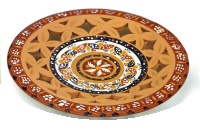 A very ancient technique, peculiar because the objects is not glazed but directly manufactered on "englobed" terracotta.
A very ancient technique, peculiar because the objects is not glazed but directly manufactered on "englobed" terracotta.
Graffito typology is normally expressed in simple shapes with preferred decorative patterns of geometrical, zoomorphic and floral motifs in blue, red and green colours. - Cartoccio (Second half of the 16th Century)
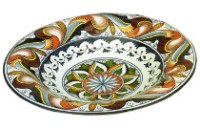 This decoration includes the motif inspired by the "crushed" leaves or gothic leaf, made up essentially of one or more leaves with curled extremities that tend to fold over and "crush" onto themselves and usually placed around a floral bed.
This decoration includes the motif inspired by the "crushed" leaves or gothic leaf, made up essentially of one or more leaves with curled extremities that tend to fold over and "crush" onto themselves and usually placed around a floral bed. - Persian Palmette (1400/1500s)
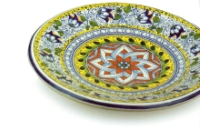 The name indicates its oriental origins; a majolica decorated with themes taken from oriental fabrics and that particularly uses a motif made up of a flower with petals similar to a pinecone.
The name indicates its oriental origins; a majolica decorated with themes taken from oriental fabrics and that particularly uses a motif made up of a flower with petals similar to a pinecone.
The flower is depicted in profile or seen from above.
The palmette in Faenza tradition maintains the usual roundness (rosette) - Peacock Feather Eye (1460/1495)
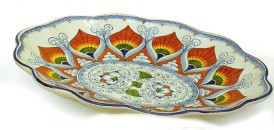 The motif of peacock's feather has a very far oriental origin and is probably inspired to the idea of the rising sun. The palette of polychrome colours is painted on the border of the plate: the development of the dominating motif came with the use of flat roof tiles, hurdles and fans. The background is an ochre-yellow, also known as the "peacock yellow" of Faenza. The prevalent colours are turquoise, green and manganese dark brown. The total effect is sumptuous and recalls the colours of the raimbow.
The motif of peacock's feather has a very far oriental origin and is probably inspired to the idea of the rising sun. The palette of polychrome colours is painted on the border of the plate: the development of the dominating motif came with the use of flat roof tiles, hurdles and fans. The background is an ochre-yellow, also known as the "peacock yellow" of Faenza. The prevalent colours are turquoise, green and manganese dark brown. The total effect is sumptuous and recalls the colours of the raimbow. - Quarters (1500)
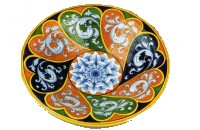 Production that features a very lively decoration that is as rich as a fabric, because it is based on regular motifs on a polychrome, blue or orange-yellow and sometimes green background, which alternate by including brank-ursine leaves, girali, cornucopias, cherubs and dolphins.
Production that features a very lively decoration that is as rich as a fabric, because it is based on regular motifs on a polychrome, blue or orange-yellow and sometimes green background, which alternate by including brank-ursine leaves, girali, cornucopias, cherubs and dolphins.
The plate bottom is closed by rays that come from the centre and reach the outside and it is of different colour in each space, by composing a light-hearted decoration. - Berettino (First half of the 16th Century)
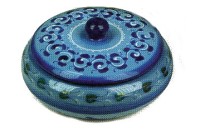 The majolica is paitend on a blue background with decorations in whyte, yellow, green and orange and with the work of Ca' Pirota, well known through documents and for the signatre of its works. A widespread decoration is a festoon with sharp leaves and rounded fruits, defining arabesques in white on blue-grey background or grotesques, serpentines, etc.
The majolica is paitend on a blue background with decorations in whyte, yellow, green and orange and with the work of Ca' Pirota, well known through documents and for the signatre of its works. A widespread decoration is a festoon with sharp leaves and rounded fruits, defining arabesques in white on blue-grey background or grotesques, serpentines, etc. - Compendiario (Half of the 16th Century)
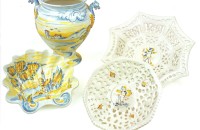 Images reduced to strokes and essentials colours, such as blue, yellow and brown on a milky white background. Rapidly sketched figures, essential brush strokes reminiscent of classical examples and decorations of the Raphaelite school. Stylised garlands surround cherubs, warriors and saints; the pod-like and moving forms enhance rhe beauty of the white glazed background. During the 17th century, the Compendiario enjoyed widespread diffusion.
Images reduced to strokes and essentials colours, such as blue, yellow and brown on a milky white background. Rapidly sketched figures, essential brush strokes reminiscent of classical examples and decorations of the Raphaelite school. Stylised garlands surround cherubs, warriors and saints; the pod-like and moving forms enhance rhe beauty of the white glazed background. During the 17th century, the Compendiario enjoyed widespread diffusion. - The Raphaelesque (Second half of the 16th Century)
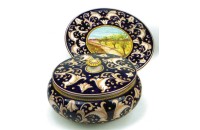 Decorative pattern inspired by the grotesque painting used by Raffello in the frescoes of Vatican rooms. It is made up of minute subjects such as panoplies, puttoes, chimaeras, and trophies of ancient arms, musical instruments and festoons, with a slight use of shoots. Whilst polychrome, the dominant colours are yellow and dark brown on a very white background (Urbino Raphaelesque) or on a blue background (Faenza Raphaelesque).
Decorative pattern inspired by the grotesque painting used by Raffello in the frescoes of Vatican rooms. It is made up of minute subjects such as panoplies, puttoes, chimaeras, and trophies of ancient arms, musical instruments and festoons, with a slight use of shoots. Whilst polychrome, the dominant colours are yellow and dark brown on a very white background (Urbino Raphaelesque) or on a blue background (Faenza Raphaelesque). - Raku (1600s, Japanese)
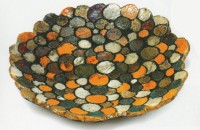 Raku means to rejoice the day, to live in harmony with things and with human beings. Raku originates from Rinku, the master of the tea ceremony, who lived in Japan in the 17th Century. Since the, this ancient Japanese ceramic technology has influenced ceramists all over the world for its particular process that through times has been gradually modified and transformed, whilst always maintaining its original charm.
Raku means to rejoice the day, to live in harmony with things and with human beings. Raku originates from Rinku, the master of the tea ceremony, who lived in Japan in the 17th Century. Since the, this ancient Japanese ceramic technology has influenced ceramists all over the world for its particular process that through times has been gradually modified and transformed, whilst always maintaining its original charm. - Gillyflower (End of the 18th Century)
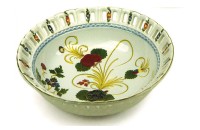 In this exotic decorative genre, a large flower, the "gillyflower of the indies" stands out over a Japanese garden; the decoration enjoyed its greatest success in Faenza at the end of the 18th Century thanks to the well-known Bottega Fiorentini. The decoration is reproduced on "berettina" majolica, created in the 16th Century by majolica manufacturers located in Faenza. The strong polychromatic suggestion made the "gillyflower" (Garofano) famous all over the world.
In this exotic decorative genre, a large flower, the "gillyflower of the indies" stands out over a Japanese garden; the decoration enjoyed its greatest success in Faenza at the end of the 18th Century thanks to the well-known Bottega Fiorentini. The decoration is reproduced on "berettina" majolica, created in the 16th Century by majolica manufacturers located in Faenza. The strong polychromatic suggestion made the "gillyflower" (Garofano) famous all over the world. - Green Vine (End of the 18th Century)
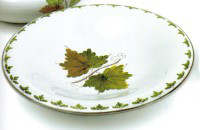 The vine-leaf is the dominant motif present in Fanza majolica at the end of the 18th Century, mostly produced by the well-known Bottega Ferniani. The motif was mainly used in dinner services, tea sets, and coffee sets and chocolate services with neo-classical shapes. The soft green colour, with manganese polishings on the "berettino" background gives each piece the unique delicacy that was typical of a very creative period in the city of Faenza.
The vine-leaf is the dominant motif present in Fanza majolica at the end of the 18th Century, mostly produced by the well-known Bottega Ferniani. The motif was mainly used in dinner services, tea sets, and coffee sets and chocolate services with neo-classical shapes. The soft green colour, with manganese polishings on the "berettino" background gives each piece the unique delicacy that was typical of a very creative period in the city of Faenza. - Acorn (End of the 18th Century)
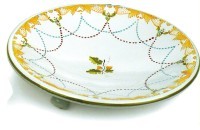 These traditional decorations were created in the ceramic boutiques of Faenza between the end of the 1700's and the beginning of the 1800's, always in sets made up of many pieces. Bottega Ferniani set this motif with neo-classical lines and tastes, maintaining it up to the middle of the 1800's. The decorative motifs of Ferniani include festoons, garlands and meanders and are distinguished for their rare elegance, typical of the taste of the most rifeined bourgeoisie.
These traditional decorations were created in the ceramic boutiques of Faenza between the end of the 1700's and the beginning of the 1800's, always in sets made up of many pieces. Bottega Ferniani set this motif with neo-classical lines and tastes, maintaining it up to the middle of the 1800's. The decorative motifs of Ferniani include festoons, garlands and meanders and are distinguished for their rare elegance, typical of the taste of the most rifeined bourgeoisie. - Pomegranate (20th Century)
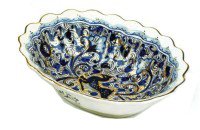 The presence of gold over blue is particularly important in this decoration. It is an articulated and complicated technique, giving a result that is reminiscent of the tastes and styles of the early 1900's. The ostentation of the precious details gives a particular light to this motif, which is inserted into modern classicism with authority and celebrates its splendour under the aegis of the Modern Age.
The presence of gold over blue is particularly important in this decoration. It is an articulated and complicated technique, giving a result that is reminiscent of the tastes and styles of the early 1900's. The ostentation of the precious details gives a particular light to this motif, which is inserted into modern classicism with authority and celebrates its splendour under the aegis of the Modern Age. - Sacred Image
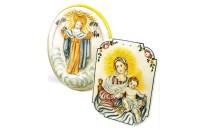 Since the middle ages sacred images have been placed along streets, at crossroads, junctions, along the boundaries of fields and near springs; they could be made of stones or wood and the plaques were fixed in a niche on the pillar pediment. The sacred image could be placed also outside a house or at the main entrance as a sign of house stability. Our collection is thoroughly hand-made and reproduces the sizes and colours of the original plaques as faithfully as possibile.
Since the middle ages sacred images have been placed along streets, at crossroads, junctions, along the boundaries of fields and near springs; they could be made of stones or wood and the plaques were fixed in a niche on the pillar pediment. The sacred image could be placed also outside a house or at the main entrance as a sign of house stability. Our collection is thoroughly hand-made and reproduces the sizes and colours of the original plaques as faithfully as possibile. - Selenium
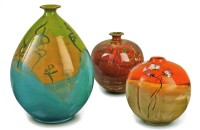 The magic of molten glass, soft and malleable, is brought out in a technique that explits the power of the fire: high temperatures mould the various pieces of selenium glass, transforming them into a unique and fascinating object. It is in this magical atmosphere that unique ceramic pieces of high artistic value are created.
The magic of molten glass, soft and malleable, is brought out in a technique that explits the power of the fire: high temperatures mould the various pieces of selenium glass, transforming them into a unique and fascinating object. It is in this magical atmosphere that unique ceramic pieces of high artistic value are created. - Artistic Costume Jewellery
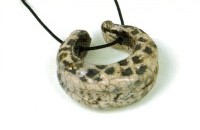 Our collections are created from the harmony between talent, creativity, research and the love of details. Created using selected raw materials (glass, hard stones and ceramics) the trinkets bring together the gift of originality to the latest fashion trends, transforming the pieces of costume jewellery into a true sign of recognition, class and originality.
Our collections are created from the harmony between talent, creativity, research and the love of details. Created using selected raw materials (glass, hard stones and ceramics) the trinkets bring together the gift of originality to the latest fashion trends, transforming the pieces of costume jewellery into a true sign of recognition, class and originality. - Restorations
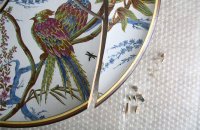 An expert restorer with a diploma at the Institute Ballardini for Ceramics Art in Faenza works for our laboratory. She deals exclusively with the restorations of any items in any material (earthenware, china, stoneware and more). If you decide to restore your object you’ll get your item back in perfect condition as it was at the beginning. With no additional fee we may also offer you an estimate of costs.
An expert restorer with a diploma at the Institute Ballardini for Ceramics Art in Faenza works for our laboratory. She deals exclusively with the restorations of any items in any material (earthenware, china, stoneware and more). If you decide to restore your object you’ll get your item back in perfect condition as it was at the beginning. With no additional fee we may also offer you an estimate of costs.

